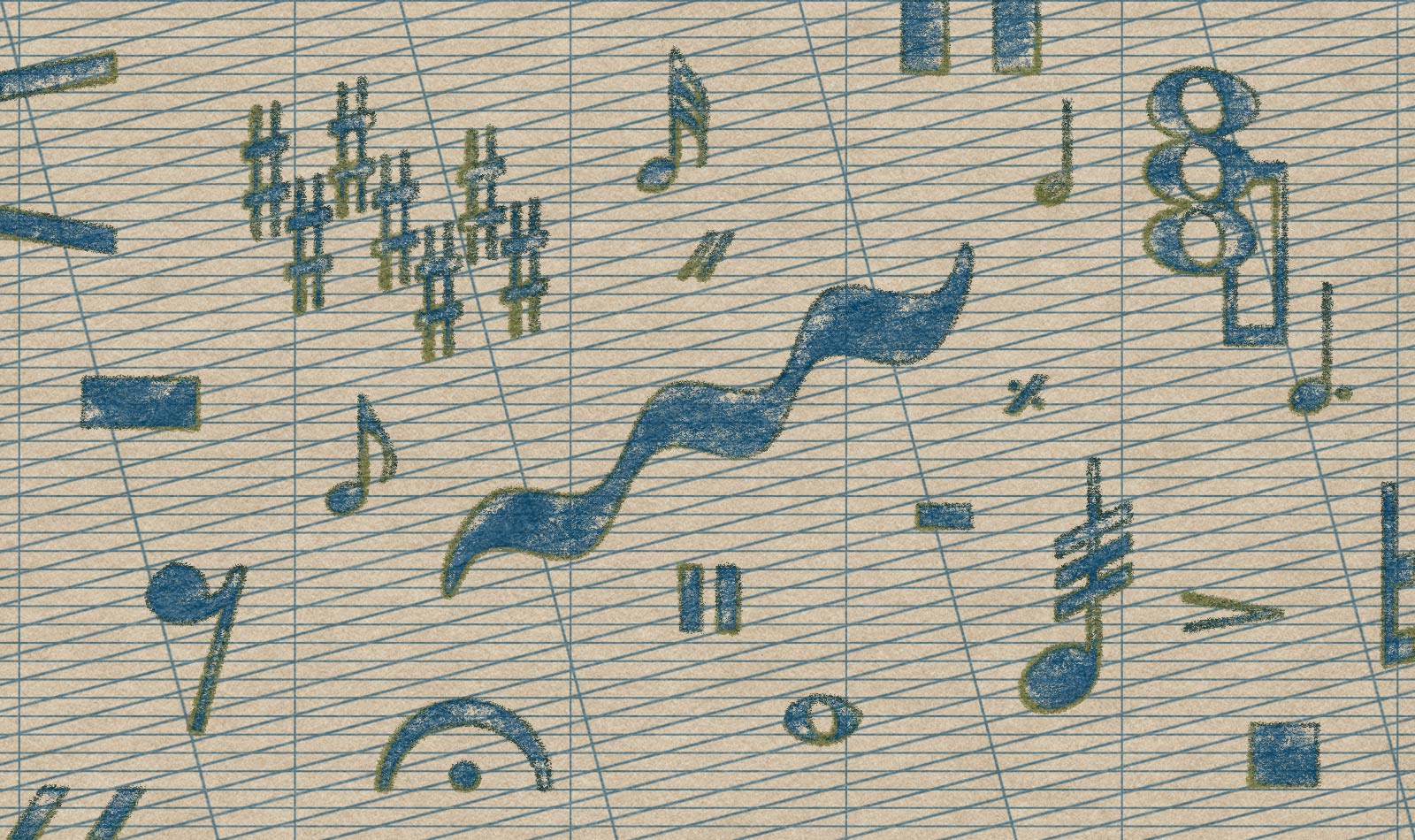By
·
August 14, 2025

There’s an old witticism, attributed to many but seemingly popularized by the comedian Martin Mull, that “writing about music is like dancing about architecture,” i.e., words can’t make sense of music. The earlier idea, from an issue of The New Republic magazine, is more illuminating: “Strictly considered, writing about music is as illogical as singing about economics. All the other arts can be talked about in the terms of ordinary life and experience. A poem, a statue, a painting or a play is a representation of somebody or something, and can be measurably described…by describing what it represents.”
The idea that music is removed from ordinary life experience is not so much wrong as misleading; it can represent the life experiences that inspire it. And music, especially notated compositions, can also be thought of and discussed in terms of architecture (sorry, Martin). Music has shape and structure, a form of architecture that exists in a single dimension: time. Composers are architects of time, none more so than the extraordinary composer, and yes, architect, Iannis Xenakis.
A Greek born in Romania in 1922, later a citizen of France, Xenakis had the kind of life that would make a gripping TV series. As a young man, he was an excellent student and athlete, sang in choirs, and learned music notation. Music was not necessarily his calling, though; he was interested in architecture and engineering, but his path came to a halt in the opening months of World War II, when the Axis Powers invaded Greece (Italy in 1940, Germany in 1941). Xenakis joined the resistance when the latter nation took over, demonstrating on the streets, and eventually, taking up arms as a member of the civilian militia. Surviving WWII, he continued to fight against the British occupation and civil war that followed, and was badly wounded facing British tanks. This left him disfigured and blind in one eye.
After Greek sovereignty was restored in 1945, Xenakis went on to earn an engineering degree. But when the first post-WWII Greek government began imprisoning leftists, Xenakis fled to Paris, in 1947. He would remain there, sentenced in absentia to death (later commuted to ten years in prison), until the right wing military government fell in 1974.
France was where he became the remarkable artist he was. He worked in Le Corbusier’s studio, collaborating with the Modernist icon on projects that included designing the Philips Pavilion at the 1958 Brussels World’s Fair. He was also working on his own compositions, going through a series of short, frustrating relationships with various teachers until he met Olivier Messiaen, who encouraged Xenakis to abandon traditional paths and follow his interest in and knowledge of architecture and math.
With those tools, and a growing expertise in technology, Xenakis, who died in 2001, found his voice as one of the most pioneering composers of the 20th century. He was on the cutting edge, one of the most important percussion and electronic composers of the era, transforming ancient Greek folk music and narratives into hard-edged and abstract music. He was there at the start of computer composing and computer-assisted music making, and founded what is now CEMAMu (Centre d’Etudes de Mathématique et Automatique Musicales). He wrote Formalized Music: Thought and Mathematics in Composition, one of the most important modern books on composition, which explains his mathematical and statistical processes in composition (and includes some of his FORTRAN code). And he was an important teacher in France and America, with notable students like Pascal Dusapin and Robert Carl.
Dancing about architecture sounds pretty dry, severe, and harsh; the same with talking about music in terms of math, computer languages, and yes, architecture. But there’s nothing dry about the sound of Xenakis—harsh and severe, perhaps, in the way the most driving energy of heavy metal can be that way. Xenakis often sounds like he’s exploding with colors, angles, sheer force. It seems to have dimensions that fill spaces that don’t even exist in nature. They do, though, in his own sonic architecture. Here are some of the key works and recordings from his legacy.
red fish blue fish/Steven Schick
Xenakis Edition 7: Percussion Works
Two labels hold a substantial amount of Xenakis’s work. One of them is Mode, which has released a multi-volume series covering the artist’s chamber, orchestral, and electronic music. Titled after Persephone, the Greek goddess who became queen of the Underworld after being abducted by Hades, this is one of Xenakis’s first major works and was an important element in building his reputation and bringing in more commissions. For six percussionists who, in live performance, are mixed throughout the audience, Persephassa utilizes space in an acoustical and architectural way that was to become a fundamental part of Xenakis’s work. That there is a mathematical design to the music that comes off as a flexible, even intuitive kind of freedom is a demonstration of the complex organicism in his music. This is a foundational volume in the Xenakis series.
Iannis Xenakis
GRM Works 1957-1962
This is another essential Xenakis release, collecting his early tape music. One of these pieces, Concret PH, was made to be played inside the Philips Pavilion, along with Edgard Varèse’s groundbreaking Poème électronique. Having designed the building, Xenakis treated this piece as part of the architecture, meant to psychologically bind the listener to the interior, including expressing the building materials through sound.This was originally played over 400 speakers installed inside the Pavilion—stereo sound will have to do.
Iannis Xenakis
Persepolis
Persepolis is not only Xenakis’s most substantial electroacoustic composition, but a historical event. It was commissioned by Mohammad Reza Pahlavi, the Shah of Iran, and made for an outdoor event as part of the long-term Shiraz (ancient Persepolis) Arts Festival. This is an 8-track tape work of synthesized sounds and was premiered in an open-air performance using dozens of speakers, lights, lasers, choreography, and more. Though not liturgical, the piece has a loose relationship to Zoroastrianism and the conflict and balance between darkness and light. Xenakis felt that, in performance, it was a syncretic mixture of sound, theater, ritual, perhaps even the possible transformation of not only human values but matter itself.
STX Ensemble & Charles Zachary Bornstein
Xenakis Edition 1: Ensemble Music
This collection spans about twenty years of Xenakis’s composing and includes some of his finest pieces, like N’Shima and Rebonds. Plektó, from the early 1990s, is less obviously structured on any kind of mathematical process (though those are deep inside), and is a rich example of the almost romantic expression that Xenakis could achieve. The language is new, but the lyricism, energy, and even moments of swooning moods, are real.
Paul Zukofsky
Brant • Scelsi • Wolpe • Xenakis • Cage • Glass • Feldman
One of the exciting features of this album from violinist Paul Zukofsky is hearing Xenakis in the company of peers like John Cage, Morton Feldman, Philip Glass, and Giacinto Scelsi. The Mikka pieces are extraordinary explorations of what the violin can do, stretching the limits of the instrument and techniques in a direction no other composer was attempting at the time. Mikka is still startling—if you didn’t know any better, you’d think someone was playing with the knob on an old-fashioned oscillator, or cranking a siren.
Iannis Xenakis
Hibiki Hana-Ma / Mycenae Alpha / Polytope de Cluny
Karlrecords is the other major contemporary source for the best of Xenakis’s music, particularly the electronic and computer music experiments. Those came together in 1979, when Xenakis created the UPIC computer system, which took graphic images and rendered them into sound. As an architect, drawing was one of his skills, and UPIC was a way to take the architecture of graphic images and turn it into architected music. Mycenae Alpha was the first piece to use this method, and is exemplary of how his technical knowledge and skill, which on the surface may seem rooted in the plain either/or of binary bits and bytes, is a (massively powerful) tool for producing music with the uncanny complexity of organic life itself.
JACK Quartet
Xenakis Edition 10: Complete String Quartets
The simplicity of a string quartet, when it’s as fine a one as JACK, reveals structural details in Xenakis’s music that can often be swamped under his masses of sound. The unusual title for the piece St-4 1,080262, hints at the origin, which is that Xenakis used a computer algorithm to compose it in 1967. The “St” in the title betrays Xenakis’s deep interest in stochastic processes and the art of making compositional choices through statistical probabilities; the piece is one that he discusses in some detail in his book. The plucks, slides, and skittering phrases seem to come at random at first, but there is a hypnotic organization to it all.
Iannis Xenakis
Electroacoustic Works
This collection from Karlrecords is one of the most important items in Xenakis’s whole discography. It includes Concret PH and other music found on the GRM album above, but extends through his entire career, with stops at the UPIC system, his first electroacoustic pieces, and Gendy 3, an exercise in stochastic synthesis. For Xenakis, there was no separation between instrumental and electronic music—he used the latter as a means to develop new techniques for the former, but everything came from the numbers and shapes he put together into things that felt fully alive, from buildings to wailing instruments.






